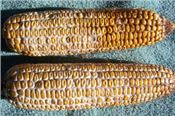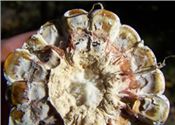|
Diplodia Ear Rot Of Corn Is Being Observed In Kentucky
DR. CARL A. BRADLEY
PRINCETON, KY.
Diplodia ear rot, caused by the fungus Stenocarpella maydis (formerly known as Diplodia maydis), has been observed in Kentucky corn fields the last couple of weeks. These observations are due to the frequent rainfall that occurred just before and throughout silking. Corn ears are most susceptible to infection by this ear rot fungus from beginning silking to approximately 3 weeks later.
Signs and Symptoms of Diplodia Ear Rot
Ears affected by Diplodia may have a white mold growing on and/or between the rows of corn kernels (Figure 1). Ears affected within 2 weeks after silking may be completely “mummified,” while in later infections, a light, cottony growth may be observed growing on the ear. Speck-sized fungal fruiting bodies (pycnidia) will be formed by the Diplodia ear rot fungus, and often can be observed on the sides of the kernels (Figure 2). Unlike most other ear rots, Diplodia ear rot typically starts at the base of the ear and continues to develop towards the tip of the ear.
What type of losses will be incurred with Diplodia ear rot?
Affected kernels will be lighter in weight than non-affected kernels, thus, overall test weight can be affected. In fields with high levels of ear rot, discounts applied at the elevator can be expected for presence of damaged kernels. In cases of severe ear rot, the cob may also be rotted, which means that pieces of the cob will not separate well from the grain during harvest. In these cases, additional discounts for presence of foreign material may also be applied at the elevator. Recent research has shown that some isolates of S. maydis may produce mycotoxins; however, no cases of poisoning of livestock that have eaten S. maydis-infected corn have been reported in North America. If feeding grain from ears affected by Diplodia ear rot, it is important to do so cautiously with attention to how livestock respond. It is also possible that other fungi may colonize ears and kernels affected by Diplodia ear rot, and some of these, like Fusarium, may produce mycotoxins that can affect livestock adversely.
My corn has Diplodia ear rot; what do I do now?
To prevent additional fungal growth and disease spread within an ear, it is best to harvest affected fields as soon as possible and dry the grain to below 18 percent moisture (or 15 percent moisture for long-term storage). If you have crop insurance, be sure to contact your agent as soon as possible, as some certain documentation may need to be made for a claim to be filed. Moldy grain should always be tested before being fed to livestock.
What can I do to prevent Diplodia ear rot next year?
The first step in managing Diplodia ear rot is to choose hybrids with better resistance. Some seed companies provide ratings of their hybrids for their susceptibility to Diplodia ear rot. For 2016, avoid planting corn back into fields that had severe Diplodia ear rot in 2015. Foliar fungicides generally have very little, if any, effect on Diplodia ear rot. ∆
DR. CARL A. BRADLEY: Extension Plant Pathologist, University of Kentucky

Figure 1. White, cottony mold beginning at the base of the ear and developing towards the tip, which is typical of Diplodia ear rot.
Photos: Carl Bradley, UK

Figure 2. Black specks on kernels are fruiting bodies (pycnidia) produced by the Diplodia ear rot fungus.
|
|